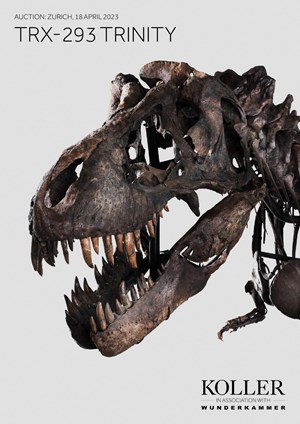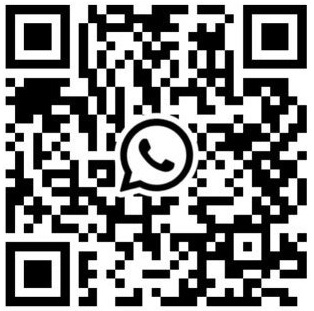
The more than 50 per cent original bone material comes from three Tyrannosaurus specimens excavated be- tween 2008 and 2013, from the Hell Creek and Lance Creek formations in Montana and Wyoming. Both sites are known for two of the most important Tyrannosaurus discoveries: ‘Sue’, which sold at auction for $8.4 million in 1997, and ‘Stan’, whose world-record hammer price of $31.8 million in 2020 catapulted dinosaur fossil prices into a realm usually reserved for the most sought-after works of art.
Fossils of dinosaurs and other living things have formed over the course of tens of thousands to hundreds of mil- lions of years. This is only possible if the conditions are right – and why fossil finds are so rare. According to the April 2021 scientific journal Nature, only 32 skeletons of adult T. rex specimens have been found worldwide. The rare skeletons of adult T. rex specimens which have been unearthed are almost all now in institutional collections. The Zurich auction is therefore an exceptional opportunity to acquire such a fossil of the highest quality.
Each of Trinity’s 293 bones was painstakingly excavated, cleaned and restored before it could be assembled. For an entire dinosaur, this process often takes between seven and ten years – an enormous effort for a team of pal- aeontologists, preparators and conservators.
Trinity’s rarity and importance is in large part due to its incredibly well-preserved skull, which comes from a single specimen. ‘Dinosaur skulls are very rare; they are among the most valuable components of fossil skeletons’, said scientific advisor Nils Knötschke, one of the world’s leading fossil preparators. ‘In fact, most dinosaurs are found without their skulls. But here we have original Tyrannosaurus skull bones, all from the same specimen’.
‘In all three specimens, the preparation was done very well, and the whole is very well preserved’, said Knötschke. ‘I was particularly surprised that not only the vertebrae, but also the filigree spines of the dorsal and cervical verte- brae are present. The very fine bones from inside the skull are usually lost, and these are also preserved in Trinity’.
‘I was impressed when I saw it, because it all seems to fit together so nicely’, said Dr Hans-Jakob Siber, palaeon- tologist and director of the Dinosaur Museum in Aathal, Switzerland. ‘It’s one of the most impressive mounts I’ve seen. The quality of the restoration plus the quality of the mount sort of breathes life again into the specimen, which lived millions and millions of years ago. TRX-293 TRINITY would certainly be an astonishing attraction in any museum in the world’.
The giant skeleton of TRX-TRINITY will be displayed in the magnificent main lobby of the historic Tonhalle con- cert hall in Zurich. From 29 March to 16 April, concert-goers as well as visitors who have reserved time slots will be able to admire the impressive Tyrannosaurus rex in a unique setting on the Lake of Zurich.
The choice of the Tonhalle Zurich as the exhibition venue for TRX-293 TRINTY is particularly appropriate for Cyril Koller, owner and CEO of Koller Auctions: ‘It was in the Kongresshaus, situated in the same building complex as the Tonhalle, where Koller held its very first auction 65 years ago’. Christian D. Link, Head of Department for ’Out of This World’, adds: ‘Exhibiting Trinity in the Tonhalle is in keeping with the spirit of the contemporary cabinet of curiosities. A dinosaur doesn’t have to been shown in a museum, it can also be in an unexpected public space, or even in someone’s home. Items taken out of their traditional context often take on a new and interesting signifi- cance’.
The ‘Out of This World’ auction at Koller, in which the T. rex Trinity will be offered, presents items from a variety of eclectic fields, including natural history, space exploration and entertainment memorabilia. What these intriguing natural and man-made objects all have in common is that they constitute a fascinating contemporary cabinet of curiosities. Some highlights include an extremely rare Mars meteorite called ‘The Red Colossus’ (lot 942, CHF 150 000 / 250 000), an Australian gold nugget weighing over 1.6 kilograms (lot 935, CHF 120 000 / 150 000), and a Soviet cosmonaut’s 1980s space suit (lot 911, CHF 65 000 / 85 000).
TRX-239 TRINITY Fact sheet
Length: 11.6 metres (38 feet)
Height: 3.9 metres (12.8 feet)
Height with base: 4.37 metres (14.3 feet) Width: 2.65 metres (8.7 feet)
Skull: 1.4 × 1.2 metres (4.5 × 3.9 feet)
From a US private collection
The bone material from which TRX-293 is assem- bled dates to the Late Cretaceous period, making it 65 to 67 million years old. T. rex was one of the last dinosaur species to exist at the time of the abrupt extinction of this order in the Cretaceous.
Estimate: CHF 5 – 8 million Auction in Zurich: 18 April 2023

ArtDependence Magazine is an international magazine covering all spheres of contemporary art, as well as modern and classical art.
ArtDependence features the latest art news, highlighting interviews with today’s most influential artists, galleries, curators, collectors, fair directors and individuals at the axis of the arts.
The magazine also covers series of articles and reviews on critical art events, new publications and other foremost happenings in the art world.
If you would like to submit events or editorial content to ArtDependence Magazine, please feel free to reach the magazine via the contact page.